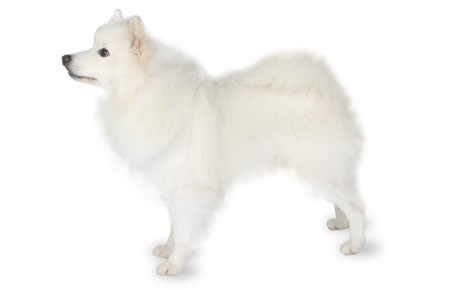American Eskimo Dog Breed Guide

Breed Group:
Companion Dogs
Get 30% off
Join our Newsletter
Sign Up Today
American Eskimo Dog Breed Information & Background
Originating from Germany, the American Eskimo Dog is a member of the Nordic breed. Also referred to as “Eskies”, these dogs have been used for hunting, herding, and hauling. Most notably, this breed played a vital role in farm life and assisted in daily tasks.
Due to their impressive intelligence, they were even used in European circuses during the 1920’s. Today these dogs are lovable family dogs, craving companionship and attention from just about anyone.
American Eskimo Personality & Behavior
These friendly companions are known to be people pleasers. They love to be surrounded by friends and family and do best when given lots of attention. The Eskie can be protective at times, which may result in barking or biting. In order to prevent this, start behavioral training early on.
Even with their protective tendencies, they are still happy, go-lucky animals and make a great addition to any household.
Are Eskies Trainable?
These eager to please pets are one of the most intelligent breeds out there. Used as circus entertainers back in the day, their obedient spirit makes them quick and focused learners. Best of all, this dog loves to learn new tricks! Many professionals advise starting young. Once they have learned the basic skills, try to enroll them in more challenging courses that will further push their intelligence.
Exercise Requirements for American Eskies
This breed requires moderate exercise on a daily basis. A walk around the park or a quick game of fetch is ideal for the American Eskie. While they may not require hours of physical activity, they still need large spaces to run and play. Keep in mind that mental stimulation is also important for this intelligent breed. Try playing different games and activities to keep them from getting bored or destructive.
Lifespan of the American Eskie
Due to its small size, the American Eskimo Dog has a lifespan of 12-15 years. Smaller breeds generally tend to have longer lives compared to larger-sized dogs. This is dependent on adequate nutrition and daily exercise.
Is the American Eskimo Dog a Popular Breed?
According to the the American Kennel Club, the American Eskie is ranked 122nd most popular breed in the United States. This independent breed is known for their iconic white coat and dark-colored eyes.
Feeding Requirements for American Eskies
The amount of food an Eskie is supposed to consume is dependent on their age and level of physical activity. Unlike most breeds, the Eskie is known to be more sensitive to food allergies, so pet food should be carefully chosen. Consult with a veterinarian to create a unique feeding regimen made specifically for your pet. Also, make sure to have fresh water available at all times.
Grooming an American Eskie
The American Eskimo dog has two thick layers that make up its fluffy coat. Daily brushing is highly recommended considering they frequently shed. Regular brushing is important to prevent mats from forming, which will also keep their fur in good condition. Clip their nails often and check their ears for any dirt or wax build-up for optimal health.
Are Eskies Good With Children?
Eskie’s level of high energy and playfulness make them a great pet for households with children. They need plenty of attention and physical stimulation which kids often provide. If trained at a young age, Eskies will have no problem living in a full household.
These dogs can be stand-offish by nature to unfamiliar people, which makes them wary of strangers. Familiarizing them with humans at a young age is crucial for these dogs to become well-mannered pets.
American Eskie Health Issues
- Progressive retinal atrophy (PRA): This retinal degenerative disease affects 13% of American Eskies. This causes the dog to lose visibility and eventually leads to blindness in both eyes.
- Hip dysplasia: 9% of Eskies are diagnosed with hip dysplasia at some point of their life. This genetic deformity of the hip socket can lead to lameness, pain, or immobility.
- Legg-Calve-Perthes disease and patella luxation: Both these orthopedic conditions are prevalent in small dog breeds. In Legg-Calve, the hip socket deteriorates, causing lameness. Patella luxation occurs when the kneecap repeatedly slips out of its groove, causing immobility.
- Hypoadrenocorticism (Addison’s disease): This disease occurs at a much higher rate in Eskies compared to most other breeds. Symptoms include lethargy, weakness, anemia, and dehydration. Luckily with proper treatment, this disease can be cured with veterinarian help.
- Epilepsy: Eskies are at higher risk for developing Epilepsy compared to other breeds. Epilepsy is a neurological disorder that results in seizures due to an internal health factor.
- Degenerative myelopathy: (the canine equivalent of Lou Gehrig’s disease) This disease affects the spinal cord and can cause paralysis in the hind legs.
- Juvenile cataracts: Believed to be hereditary, this problem occurs most commonly is younger Eskies. Cataracts hinder sight and can cause blindness if gone untreated.
Other Resources
National Breed Website: American Eskimo Dog Club of America
Rescues: Heart Bandits





